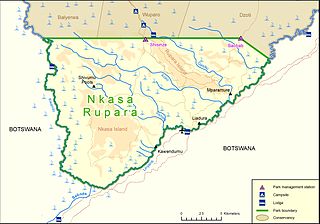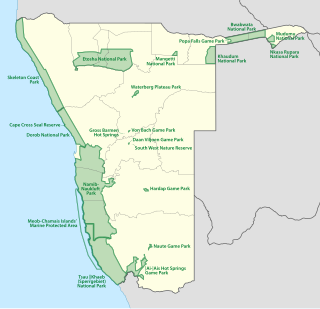Related Research Articles

The Zambezi is the fourth-longest river in Africa, the longest east-flowing river in Africa and the largest flowing into the Indian Ocean from Africa. Its drainage basin covers 1,390,000 km2 (540,000 sq mi), slightly less than half of the Nile's. The 2,574 km (1,599 mi) river rises in Zambia and flows through eastern Angola, along the north-eastern border of Namibia and the northern border of Botswana, then along the border between Zambia and Zimbabwe to Mozambique, where it crosses the country to empty into the Indian Ocean.

A transboundary protected area (TBPA) is an ecological protected area that spans boundaries of more than one country or sub-national entity. Such areas are also known as transfrontier conservation areas (TFCAs) or peace parks.

Great Limpopo Transfrontier Park is a 35,000 km² peace park that is in the process of being formed. It will link the Limpopo National Park in Mozambique, Kruger National Park in South Africa, Gonarezhou National Park, Manjinji Pan Sanctuary and Malipati Safari Area in Zimbabwe, as well as the area between Kruger and Gonarezhou, the Sengwe communal land in Zimbabwe and the Makuleke region in South Africa.

Sioma Ngwezi National Park is a 5,000-square-kilometre park in the south west corner of Zambia. It is undeveloped and rarely visited, lacking roads and being off the usual tourist tracks, but this may change in the future.

Thuli Parks and Wildlife Land is a protected area in south-western Zimbabwe. It comprises four areas within the Zimbabwe Parks and Wildlife Estate and covers the entire west bank of the Shashe River within the Thuli Circle.
Mavinga is a National Park in Kuando Kubango Province in south-eastern Angola. It covers an area of 46,076 square kilometres (17,790 sq mi). The Park was proclaimed in 2011 along with the neighbouring Luengue-Luiana National Park, which measures 22,610 square kilometres (8,730 sq mi). The two parks are contiguous and managed as a single unit. The parks were created to conserve the areas’ high ecological and biological value. Mavinga forms the western border of Africa's largest conservation area, the Kavango-Zambezi Trans-Frontier Conservation Area.

Greater Mapungubwe Transfrontier Conservation Area is a cultural TFCA, formerly known as the Limpopo–Shashe Transfrontier Conservation Area.
Kavango–Zambezi Transfrontier Conservation Area is the second-largest nature and landscape conservation area in the world, spanning the international borders of five countries in Southern Africa. It includes a major part of the Upper Zambezi River and Okavango basins and Delta, the Caprivi Strip of Namibia, the southeastern part of Angola, southwestern Zambia, the northern wildlands of Botswana and western Zimbabwe. The centre of this area is at the confluence of the Zambezi and Chobe Rivers where the borders of Botswana, Namibia, Zambia and Zimbabwe meet. It incorporates a number of notable national parks and nature sites, including Chobe National Park, Hwange National Park, and the Victoria Falls. The region is home to a population of approximately 250,000 animals, including the largest population of African Elephants in the world.
The Zinave National Park is a protected area in Mabote District of Inhambane Province, Mozambique, created by decree on 26 June 1973.

Bwabwata National Park is a protected area in northeastern Namibia that was established in 2007 and covers 6,274 km2 (2,422 sq mi). It was created by merging Namibia's Caprivi Game Park and Mahango Game Park. It is situated in the Zambezi and Kavango East regions, extending along the Caprivi Strip. It is bounded by the Okavango River to the west and the Kwando River to the east. Angola lies to the north and Botswana to the south.

The Zambezian and mopane woodlands is a tropical and subtropical grasslands, savannas, and shrublands ecoregion of southeastern Africa.

Mudumu is a National Park in Caprivi Region of north-eastern Namibia. Established in 1990, the park covers an area of 737 square kilometres (285 sq mi). The Kwando River forms the western border with Botswana. Various communal area conservancies and community forests surround Mudumu National Park.

Nkasa Rupara National Park, also Nkasa Lupala National Park, formerly Mamili National Park, is a national park in Namibia. It is centered on the Nkasa and Rupara islands on the Kwando/Linyanti River in the south-western corner of East Caprivi. Botswana lies to the west, south and east, and Sangwali village to the north. It is Namibia's largest formally protected wetland area. It is one of Namibia’s protected areas that benefits local communities surrounding parks. The unfenced park forms a trans-boundary link for wildlife migration between Angola, Botswana, Namibia and Zambia. Nkasa Rupara is part of the Kavango Zambezi Transfrontier Conservation Area.

NamParks or the Namibian National Parks Programme is a programme of the Namibian Ministry of Environment and Tourism (MET). It was established in 2006 and is supported by the Federal Republic of Germany through KfW. It works in Bwabwata, Khaudum, Mudumu and Nkasa Rupara national parks in north eastern Namibia. The parks are part of a larger conservation area, the Kavango–Zambezi Transfrontier Conservation Area. They contain biodiversity and habitat that are not found elsewhere in Namibia. They are also important for tourism. Partners believe that investment in the north eastern parks contributes to the ecological and economic development of the KAZA TFCA.

The protected areas of Namibia include its national parks and reserves. With the 2010 declaration of Dorob National Park, Namibia became the first and only country to have its entire coastline protected through a national parks network. Protected areas are subdivided into game reserves and/or nature reserves, such as special protected area, wilderness areas, natural areas, and development areas. There are also recreation reserves. Facilities in the national parks are operated by Namibia Wildlife Resorts. Over 19% of Namibia is protected, an area of some 130,000 square kilometres. However, the Ministry of Environment & Tourism auctions limited hunting rights within its protected areas. The Namibia Nature Foundation, an NGO, was established in 1987 to raise and administer funds for the conservation of wildlife and protected area management. Communal Wildlife Conservancies in Namibia help promote sustainable natural resource management by giving local communities rights to wildlife management and tourism.

The Southeast African cheetah is the nominate cheetah subspecies native to East and Southern Africa. The Southern African cheetah lives mainly in the lowland areas and deserts of the Kalahari, the savannahs of Okavango Delta, and the grasslands of the Transvaal region in South Africa. In Namibia, cheetahs are mostly found in farmlands. In India, four cheetahs of the subspecies are living in Kuno National Park in Madhya Pradesh after having been introduced there.
The following index is provided as an overview of and topical guide to the protected areas of South Africa:

The Zambezi basin is an African drainage basin, whose main flow is the Zambezi River, being the fourth largest basin on the continent, in addition to being the most important basin in southern Africa. It covers approximately 1,390,000 km², crossing regions with high population density, sometimes in areas of low density, such as the Kavango–Zambezi Transfrontier Conservation Area. The Zambezi Watercourse Commission (ZAMCOM) has been in existence since 2004 with the aim of strengthening cooperation in sharing its resources concerned. Another supranational initiative for watershed management is Zambezi River System Action Plan (ZACPLAN).
References
- ↑ "Transfrontier Conservation Areas". environment.gov.za.
- ↑ "Transfrontier Conservation Areas". environment.gov.za.
- ↑ "About KAZA". kavangozambezi.org.
- ↑ "TRANS-FRONTIER CONSERVATION AREA". wildlife.gov.mw.
- ↑ "Transfrontier Conservation Areas". environment.gov.za.
- ↑ "Transfrontier Conservation Areas". environment.gov.za.
- ↑ "Transfrontier Conservation Areas". environment.gov.za.
- ↑ "Transfrontier Conservation Areas". environment.gov.za.
- ↑ "Liuwa Plains-Mussuma Transfrontier Conservation Area". tfcaportal.org.
- ↑ "Lower Zambezi – Mana Pools Transfrontier Conservation Area". tfcaportal.org.
- "Peace Parks Annual Review and Financial Statements 2018" (PDF) Retrieved 2020-03-19.
- "Peace Parks Annual Review and Financial Statements 2017" (PDF) Retrieved 2020-03-19.
- "Peace Parks Foundation". Edmond de Rothschild Group. Retrieved 2014-11-06.
- "Peace Parks Foundation". SANGONeT. Retrieved 2014-11-06.
- Rosaleen Duffy (2001). "Peace parks: The paradox of globalisation1". Geopolitics. 6 (2): 1–26. doi:10.1080/14650040108407715.
- Marloes van Amerom; Bram Büscher (2005). "Peace parks in Southern Africa: bringers of an African Renaissance?". Journal of Modern African Studies. 43 (2): 159–182. doi:10.1017/S0022278X05000790. hdl: 1765/21698 .
{{cite journal}}: CS1 maint: multiple names: authors list (link) - "Peace Parks Annual Review and Financial Statements" (PDF). 2013. Retrieved 2014-11-06.